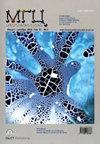单取代季铵化对叔丁基噻甲酸芳烃的一锅法合成
IF 1
4区 化学
Q4 CHEMISTRY, MULTIDISCIPLINARY
引用次数: 1
摘要
用远端二溴丙基取代对叔丁基噻吩芳烃与几种含氮亲核试剂反应,首次证明了一锅法合成对叔丁基噻吩芳烃单取代季铵化衍生物的可能性。采用二维核磁共振波谱和高分辨率质谱等现代物理方法对反应产物的结构和组成进行了分析。对反应混合物的详细分析使揭示脱烷基机制成为可能,脱烷基机制包括溴离子对O-CH 2碳原子的亲核攻击,随后形成含溴的加合物,用质谱法检测。以经典的二溴丙基取代对叔丁基杯[4]芳烃为底物,不发生脱烷基反应,生成双季铵化咪唑杯[4]芳烃盐,收率高。两个大环反应性的差异与大环尺寸的不同有关:对于大尺寸的二取代噻吩杯芳烃,两个未取代的羟基仅与一个烷氧基形成氢键,而在经典的杯芳烃中,形成两个成对的氢键。因此,硫杯芳烃的两个烷氧基中的一个更容易受到亲核攻击;此后形成的硫杯芳烃核负离子由两个氢键同时稳定。本文章由计算机程序翻译,如有差异,请以英文原文为准。
One-pot Synthesis of Mono-substituted Quaternized p-tert- Butylthiacalix[4]arenes
The possibility of one-pot synthesis of mono-substituted quaternized derivatives of p-tert-butylthiacalix[4]arene was demonstrated for the first time by the reaction of distally di-bromopropyl substituted p-tert-butyl thiacalix[4]arene with several nitrogen-containing nucleophiles. The structure and composition of the reaction products were analyzed by modern physical methods, including two-dimensional NMR spectroscopy and high-resolution mass spectrometry. A detailed analysis of the reaction mixtures made it possible to reveal the dealkylation mechanism, which consists in the nucleophilic attack of the bromide ion on the O-CH 2 carbon atom, followed by the formation of a bromine-containing adduct, detected by mass spectrometry. Dealkylation does not occur when the classical di-bromopropyl substituted p-tert-butyl calix[4]arene is used as a substrate - the bis-quaternized imidazolium calix[4]arene salt is formed in a high yield. Such a difference in the reactivity of two macrocycles is associated with the difference in the sizes of the macrocycles: in the case of di-substituted thiacalixarene, which has a large size, two unsubstituted hydroxyl groups form a hydrogen bond with only one alkoxy group, while in the classical calix[4]arene, two paired hydrogen bonds are formed. As a result, one of the two alkoxy groups of the thiacalixarene is more accessible for nucleophilic attack; formed thereafter thiacalixarene nucleofuge-anion is stabilized by two hydrogen bonds at once.
求助全文
通过发布文献求助,成功后即可免费获取论文全文。
去求助
来源期刊

Macroheterocycles
CHEMISTRY, MULTIDISCIPLINARY-
CiteScore
2.30
自引率
21.40%
发文量
0
期刊介绍:
The journal is a forum for the specialists investigating macroheterocyclic compounds. It publishes original experimental and theoretical works (full papers and short communications) and reviews on synthesis, structural characterization, physical and coordination chemistry as well as practical application of macroheterocycles.
 求助内容:
求助内容: 应助结果提醒方式:
应助结果提醒方式:


